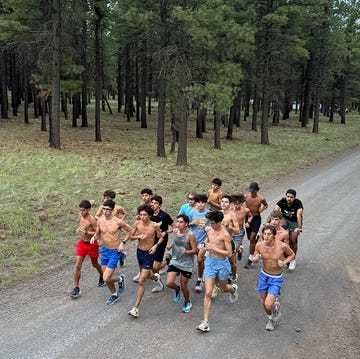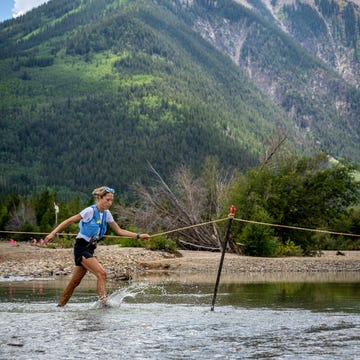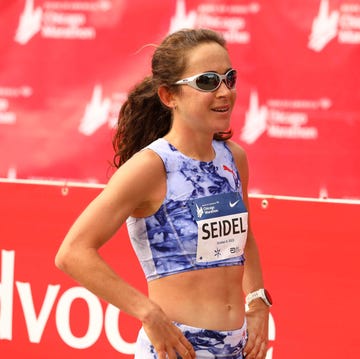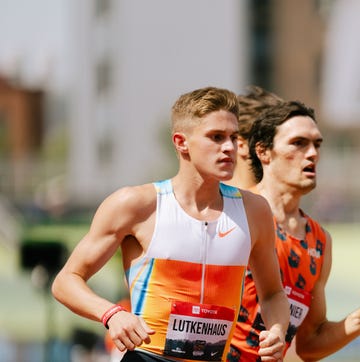Few athletes, in any sport, had as successful of an Olympics as Gabby Thomas.
Over a five-day span, the 27-year-old won gold in three events—the 200 meters, 4x100-meter relay, and 4x400-meter relay. And frankly, none of the races were even that close.
In the 200 final on August 6, Thomas took the lead 80 meters in and never let the field back in the race, winning in a time of 21.83 and holding off 100-meter gold medalist Julien Alfred. Three days later, in the 4x100, she ran the third leg, handing off to Sha’Carri Richardson, who finished the job for the U.S. And in the 4x400 on Saturday, Thomas split 49.30 to help the Americans break the national record.
Thomas is leaving Paris with the most gold medals of any track athlete at the 2024 Games.
Runner’s World sat down with the New Balance athlete on Sunday to debrief on the whirlwind week and talk about what’s next.
Triple gold was always the plan
While Thomas is known as a 200-meter specialist, she’s one of the most versatile sprinters in the world. She can step down to the 100, or up to the 400, with relative ease. In fact, she was the only woman to run both relays at the Olympic finals.
Along with her coach, Tonja Buford-Bailey, Thomas decided to train throughout the year with the triple in mind, even if that meant sacrificing some early post-season results. On May 18, she raced the 200 meters at the Los Angeles Grand Prix but finished an uncharacteristic sixth in what would be her slowest time of the season, 22.68.
Expectedly, some people on social media questioned her form, but Thomas cleared the air in a post on X, writing that she was in the midst of a tough training block, but she wanted to stay in the race for the fans. “Everything is going according to plan,” she assured them.
She was right. Thomas wouldn’t lose another race the entire season over 200 meters, and she entered the Olympics as the odds-on favorite to win, even after 2023 world champion Shericka Jackson withdrew right before the first round.
Looking back on her Olympic performances, Thomas said she’s extremely pleased with herself. If she was grading herself like an exam in school, she said she would give herself a 90/100, or an “A.”
“I’m a perfectionist,” she said. “There are always things to improve on, but I came and I got the job done … Competing on that level, on that stage, always has its challenges, so to come out with the gold, it’s just such an accomplishment. I’m so grateful.”
She ran cross-country in high school, but it wasn’t her thing
Thomas puts a strong emphasis on fall training to get ready for the long outdoor season in the summer. In high school—Thomas grew up in western Massachusetts—she ran a season of fall cross-country, but she quickly realized the long distances weren’t for her.
“It was awful,” she said, laughing. “It was so long. I did a 5K and … I started walking in the middle of it because I was so tired. But that was my best time. It was a PB for me.”
Thomas experimented with some other events and distances early in her career, too. She won New England Prep School championships in the 100 and long jump, and scored points in the triple jump. Thomas went on to win three Ivy League Heptagonal Championships in the long jump while attending Harvard, but the highlight of her college career was setting the NCAA indoor record in the 200 meters (22.38.)
She ran in the same spikes as Elle St. Pierre
If you looked closely, you might have noticed that nearly all the New Balance-sponsored athletes were wearing the same racing shoe: the FuelCell SuperComp MD-X v3.
Traditionally, spikes designs have differed depending on race distance. Sprinters typically wear spikes with more pins and a more aggressive spike plate than distance runners, but most of the New Balance athletes at the Games, from Thomas to Sydney McLaughlin-Levrone to Elle St. Pierre in the 1500 meters, were the same. (St. Pierre also wore the shoes in the 5,000 meters at the Olympic Trials.)
When New Balance was experimenting with carbon plate technology, they unexpectedly found that their athletes performed best in the same spike, especially an athlete like Thomas who runs multiple events.
“[The shoe] is so versatile,” she said. “I tried a couple of the spikes, and I just felt so comfortable in that one. I ran some really good races in it, and so I really don’t like to change things when they’re working … It’s my gold-medal spike.”
She thrived off the energy in Paris
The spectacle of the Olympics, understandably, can be overstimulating for athletes. But Thomas seemed to shine in the setting. She ran well at the 2021 Tokyo Olympics, taking bronze in the 200 and silver in the 4x100, but there were no fans because of the COVID-19 pandemic.
This time around, the crowd—and the purple track—was enchanting to Thomas. The track and field events were held at the Stade de France, which is the largest stadium in the country and can seat over 70,000 people.
“It was unlike anything I’ve ever experienced before,” she said. “It was just so much fun to compete in front of [the fans.] The first time I walked out there, I was just like, ‘Whoa.’ Nothing can prepare you for that.”
The fans seem to like her, too; she’s gained over 450,000 followers on Instagram since she ran her first event, according to Social Blade.
Thomas will now take a short break from competing, but she’s considering running some Diamond League races later this season.
In the background, she’s been working with entrepreneur Alexis Ohanian to launch the Athlos track meet—an all-women’s competition that’s set for September 26 in New York City. The race is promising “the largest prize purse ever for a women’s track event,” with $60,000 going to the winner of each race and prize money down to sixth place.
The event is supposed to have a heavy emphasis on entertainment as much as competition. Rapper Megan Thee Stallion was announced as a performer last month, and the competition should be TV-friendly.
Thomas is excited: “I think it’ll be a great step forward in track and field and in women’s sports in general.”
Theo Kahler is the news editor at Runner’s World. He’s a former all-conference collegiate runner at Winthrop University, and he received his master’s degree in liberal arts studies from Wake Forest University, where he was a member of one of the top distance-running teams in the NCAA. Kahler has reported on the ground at major events such as the Paris Olympics, U.S. Olympic Trials, New York City Marathon, and Boston Marathon. He’s run 14:20 in the 5K, 1:05:36 in the half marathon, and enjoys spotting tracks from the sky on airplanes. (Look for colorful ovals around football fields.)















